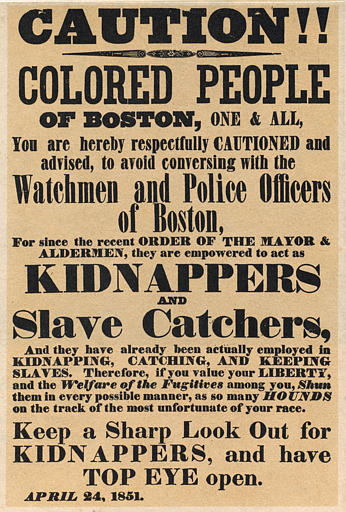
From the PBS Series, Africans in America "Kidnapping in Pennsylvania (1783 - 1826)" -- The passage of the 1793 Fugitive Slave Act, fueled a huge and vastly profitable underground industry that took full advantage of the inferior legal status of free and enslaved blacks. The law made it possible for a white person to claim any black person as a fugitive, and placed the burden of proof on the captive. Free blacks living in Philadelphia, Cincinnati, and other cities near the borders of slave states were especially vulnerable, though several well-known cases demonstrate that no state was immune.
Slave speculators (or slavers) -- who legally purchased the rights to runaways, captured them, and then resold them at a profit -- often seized blacks at random, banking on their inability to prove their status to the satisfaction of a magistrate. In one case, a slave speculator who attempted to seize AME Bishop Richard Allen found himself in debtors' prison, charged with attempted kidnapping, false accusation and perjury by Allen, who dropped the charges several months later.

Although Pennsylvania passed a law against kidnapping in 1788, penalties were so light as to be ineffective. In a 1799 petition, Absalom Jones and other Philadelphia blacks petitioned Congress against slavery, specifically focusing on the Fugitive Slave Act and the practice of kidnapping.
In 1820 lobbying by PAS produced a stronger anti-kidnapping law, providing penalties of twenty-one years imprisonment at hard labor. The increased demand for slaves created by the passage of the Missouri Compromise, though, made the rewards of kidnapping worth the risk to many slavers.
That same year, John Read, a free man who lived in Kennet Township (in Chester County, Pennsylvania) killed two white men who broke into his home in an attempt to capture and enslave him. It was well known that Read carried a pistol, having had a previous experience with an attempted kidnapping several years before. On the night of December 14, two men named Shipley and Griffith called for Read to open his door, claiming to have a search warrant for stolen goods. Suspecting that they were kidnappers, Read advised them to return at daylight to conduct their search.

When the men ignored his warning and burst in with pistols cocked, Read called out, "It is life for life!" Griffith, a slavemaster, yelled "Rush on, Shipley; damn the Negro, he won't shoot." Read shot one and clubbed the other to death. He was acquitted of murdering Griffith, but convicted of manslaughter in the death of agent Shipley, for which he was imprisoned for nine years. The state had sought the death penalty.
In a letter dated October 21, 1823, from Charleston, South Carolina, Phillis Cox sought the help of Dr. James Rush, the son of Dr. Benjamin Rush and himself a physician, in proving her free status. She requested that he "look at the re[c]ording-office and get a coppy of my free papers and send them on to me as I am made a slave heair." Cox included a list of "names of persons that well noes me to be free Borne in that state." Southern states required that a white person appear in person to identify the captive; the testimony of blacks, whether slave or free, was inadmissible, either to establish free status or in the prosecution of the kidnapper.
A kidnapping ring discovered to be operating in and near Philadelphia in the mid-1820s provided evidence of how similar rings functioned. With relatives and a mulatto man as accomplices, Joseph Johnson preyed on children between the ages of eight and fifteen, luring them onto a ship with promises of work, then transporting them south and selling them into slavery.
Children provided a low-risk target, even if their cases somehow attracted legal intervention. Dramatic changes in children, resulting from growth and physical abuse, made indisputable identification difficult even for relatives -- whose testimony would not have been allowed in any case -- much less for a white patron, who would have to bear the expense of traveling South to make the identification. In a two-year period, at least a hundred black children were abducted from Philadelphia alone. (source: PBS)
No comments:
Post a Comment